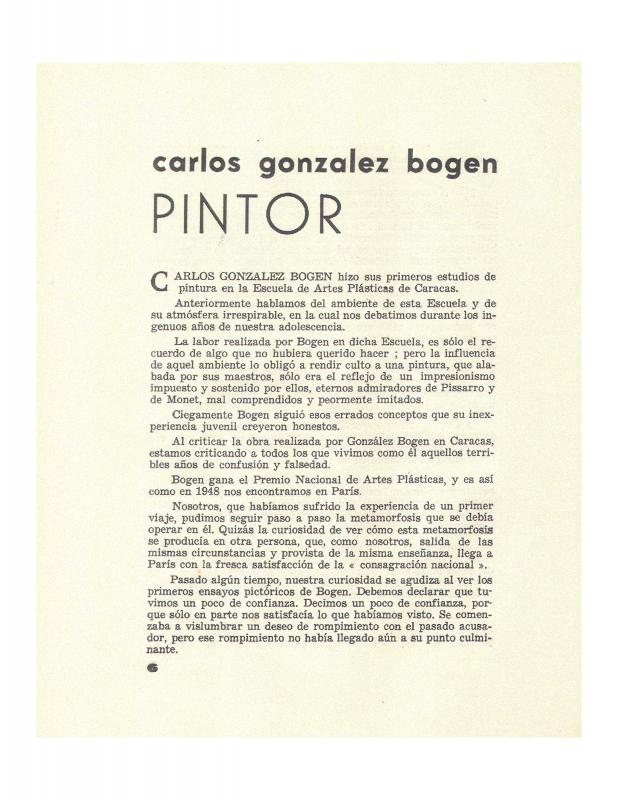La Barraca de Mari-Pérez was founded in 1945 and enjoyed a brief existence. Its members included Pedro León Zapata, Sergio González, Celso Pérez, Enrique Sardá, Raúl Infante, Luis Guevara Moreno, Perán Erminy, and other students who had been expelled from the Escuela de Artes Plásticas de Caracas for participating in a protest against the School. It was called La Barraca de Mari-Pérez because the group organized a ceramics workshop and other art projects in an old shed in the Caracas neighborhood of the same name. In 1947 most of the group received grants from the Venezuelan government to study in Mexico City. Two of them (Guevara Moreno and Erminy) went to Paris and, eventually, joined Los Disidentes.
This article conveys a sense of the impact caused by the violent emergence of Los Disidentes (1950) in Venezuelan cultural circles. Here, artists from the same generation angrily and aggressively decline when Los Disidentes invite Latin American youth to join their crusade to transform traditional Venezuelan culture because they believe that Los Disidentes appropriated conflicts that were theirs too. Over and above the jealousy that La Barraca de Mari-Pérez may have felt over the Los Disidentes group’s “successes,” this article was a harbinger of the most important debate in Venezuelan art history about, for example, whose work tends toward social realism? How did La Barraca de Mari-Pérez operate, so clearly influenced by Mexican muralism? What arguments were used to refute the European abstraction of Los Disidentes?
The reply to this article appeared in “Los Disidentes y sus críticos,” which was published in the newspaper El Nacional, on August 3, 1950 [see doc. no. 813952] and reprinted in the magazine Los Disidentes, no. 5; on the latter occasion a note was added to the article, signed by Erminy, Guevara, and Debourg.
Los Disidentes was a group started in Paris in 1950 by a number of Venezuelan artists and writers who lived there from 1945 to 1952. From their home base in Paris they decided to challenge the official education provided by the Escuela de Artes Plásticas de Caracas, which was based entirely on landscape painting and nativist art. In the spirit of their name, Los Disidentes sought to breathe new life into traditional and academic art through an assimilation of the values espoused by European abstraction. The painters in the group included Alejandro Otero (1921–90), Mateo Manaure, Pascual Navarro, Luis Guevara Moreno, Carlos González Bogen, Narciso Debourg, Perán Erminy, Rubén Núñez, Dora Hersen, and Aimée Battistini, in addition to J. R. Guillent Pérez, who was a philosophy student at the time. They were subsequently joined by other Venezuelan artists, such as Armando Barrios, Miguel Arroyo, Oswaldo Vigas, Omar Carreño, Alirio Oramas, and Régulo Pérez. They published a magazine, named after their group, Los Disidentes, which carried all their news, and appeared a total of five times.
To read other articles about this group, see by Alejandro Otero “Del arte abstracto” [doc. no. 813611], “Las ‘placas al mérito’ y la juventud” [doc. no 813429], and “Mateo Manaure en la pintura: un joven pintor venezolano, en viaje hacia París” [doc. no. 813639]; by Carlos González Bogen “La escuela ‘de los paisajistas’ de Caracas” [doc. no. 813695] and “‘De nuevo’ Los Disidentes” [doc. no. 813667]; by Mateo Manaure “Carlos González Bogen: pintor” [doc. no. 813583]; by Narciso Debourg “En torno a la pintura de hoy” [doc. no. 813597]; and by J. R. Guillent Pérez both “Lo latinoamericano y lo occidental [Parte I]” [doc. no. 813723], and “Lo latinoamericano y lo occidental (Continuación)” [doc. no. 813478].










